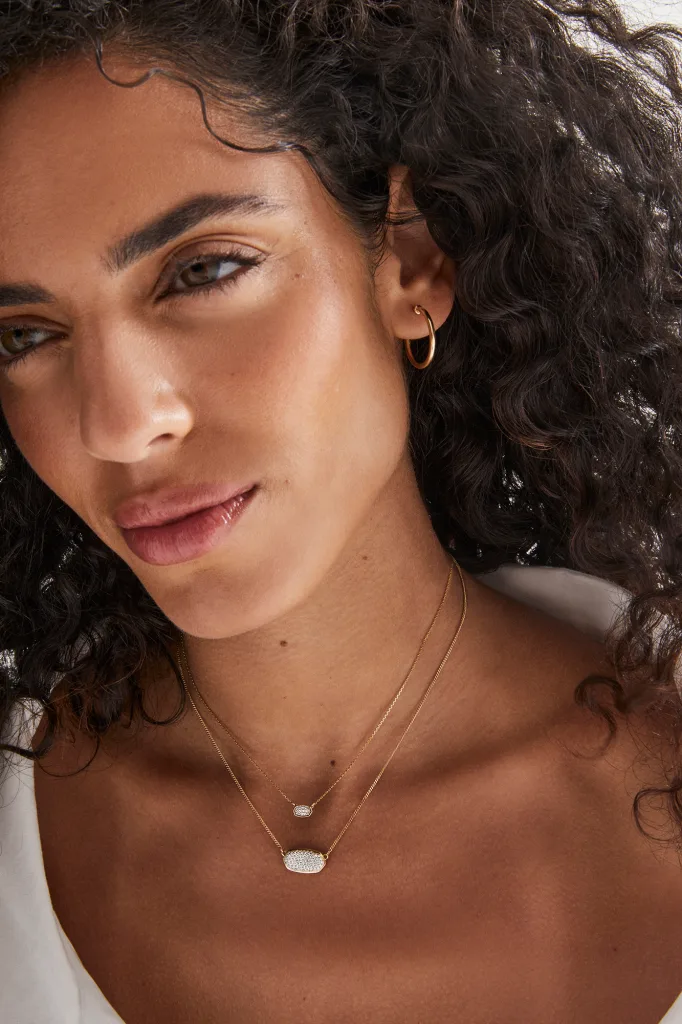How popular is Kendra Scott’s Elisa necklace? Enough to sell one every minute
If you have a tween girl in your life, she’s very likely obsessed with a dainty necklace with an oval pendant. The Elisa necklace, made by the Austin-based jeweler Kendra Scott, comes in every color of the rainbow. Thanks, in part, to the brand’s cult following among the tween set, an Elisa necklace is sold every minute.
Eleanor Woodsworth, an 11-year-old in Brooklyn, discovered the brand over the summer. She perused the many Elisa options in store, settling on a turquoise pendant, with a vintage gold chain. To buy it, she dropped $70 of the money she earned at her after-school job at a dance studio. When she started sixth grade in this fall, she suddenly saw the Elisa everywhere. “I’ve seen hundreds of girls wearing these necklaces,” she says. “It’s part of the clean girl preppy style. It’s preppy but with more neutral, understated colors.”
Kendra Scott, now 50, founded her eponymous brand 22 years ago as a single mother, with only $500. She wanted to create the kind of jewelry she couldn’t find: affordable and elegant, that sits somewhere between tacky costume jewelry and pricey fine jewelry. She made the first pieces herself, selling them at boutiques in Austin. The concept took off. This year, it will make upwards of $500 million in revenue through its website, fleet of 130 stores, and retail partners ranging from Bloomingdale’s to Target.
The brand’s success is partly due to its broad appeal. It has found a way to win over millennial moms, along with their tween daughters. This is not an easy feat, given how different tastes and budgets are across these demographics. Many other brands that are hot with today’s middle-schoolers—like Garage and Edikted—thrive precisely because parents would never shop at these stores. Yet, Kendra Scott has cracked the code. And it’s fueling the brand’s enormous growth.

The Elisa Effect
Kendra Scott’s design team first developed the Elisa necklace eight years ago, as a way to lean into Scott’s love of colorful stones. The basic necklace, which costs $55, comes in more than 25 colors, including mother-of-pearl, emerald green, and fuchsia that comes on 14K gold-plated brass or silver necklaces. (The brand has patented techniques to create pigmented glass that looks like precious stones, but are much more affordable.) The brand also sells more premium Elisas, made in collaboration with Dolly Parton, Disney and the show Yellowstone, at higher prices. You can even get a diamond version of the Elisa for $2,150.
Shortly after the Elisa came out, the brand discovered that the necklace was resonating with teens and college students. They loved the idea of being able to pick a color that reflected their personality or loyalty to their team. “They love customization,” says Tom Nolan, Kendra Scott’s CEO. “The necklace comes in so many colors, they can effectively personalize it to suit their tastes.”
Last year, Kendra Scott decided to capitalize on the wild success of the Elisa. It launched the Hey, Elisa! tour, where it went from colleges across the South, right in time for sorority recruitment season. The brand did a pop-up, where students could customize their Elisa necklaces, while also giving away free coffee and free gifts. Some students showed up at 6 a.m., waiting for the 10 a.m. pop-up to begin. The Elisa, which was already a hit, became a phenomenon. College students would feature the necklaces in their outfit-of-the-day videos on TikTok and Instagram. “It was staggering,” Nolan says. “We’ve now sold many millions of them. They’re our number one selling item of all time.”
By the time Woodsworth started sixth grade this fall, the Elisa had already trickled down to the middle school set. And while $55 is an affordable luxury to a college student, it can be expensive for tweens saving up their allowance. To make the necklaces more accessible, Kendra Scott gives students a 15% discount, and also offers regular promotions.
Woodsworth, in love with her Elisa necklace, decided she wanted to add another Kendra Scott piece to her collection. She started checking Kendra Scott’s website regularly. Then, one day, there was a two necklaces for $70 deal on the website. She pounced. She picked up chain necklace with delicate crystals on it, along with a pink heart pendant necklace for a friend’s birthday.

Winning Moms, Daughters, and Grandmas, Too
Nolan says it is crucial for Kendra Scott to create products that appeal to young consumers, like the Elisa. But it’s also important not to change the brand at a fundamental level. “We don’t want to be pigeonholed as a tween brand,” he says. “We love tweens and we’re eager to talk to them. But it’s important for us to have something for everybody.”
Tweens make up a relatively small percentage of Kendra Scott’s overall business. Scott launched her brand in her mid-twenties and appealed to women much like herself. Over the last two decades, her customers have grown with her. Today, Nolan says that 40% of customers are 45 and older, and almost 20% are upwards of 60. This means the other 40% are a mix of the younger generations, which includes millennials, Gen Z, and Gen Alpha.
Appealing to such a broad audience is tricky. For instance, discounts that are crucial to making products accessible to tweens might cheapen the brand for an older consumer. Nolan says that Kendra Scott gets around this by offering higher-end products for consumers who have perhaps graduated from the more affordable pieces. It now has fine jewelry that includes lab-grown diamonds and other precious stones, along with a demi-fine jewelry that features gold vermeil.
But fundamentally, Nolan believes it is possible to create a brand that can be aspirational to people of all ages. This means creating jewelry that is classic, delicate, colorful, and looks expensive. “I think brands can make the mistake of changing their design to be more in line with what tweens like,” he says. “We want a 14-year-old and a 40-year-old to be able to wear the same product, without looking ridiculous. We want to transcend trends.”
It’s a smart strategy because as Woodsworth will tell you, tween tastes are fickle. Remember when Stanley water bottles were all the rage? At Woodsworth’s middle school, everybody has moved on. And those Lululemon belt bags that everybody had? “They’re going out of style,” she says.
So it’s unclear whether Kendra Scott’s necklaces will be still be catnip to tween girls eager to reflect the “preppy clean girl” style. But Nolan isn’t too worried. He believes that if the brand keeps making beautiful, affordable products, those tween girls will eventually come back to the brand. “We’re playing the long game,” he says.
ABOUT THE AUTHOR
Fast Company
(5)



